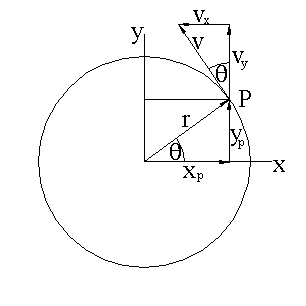Centripetal Acceleration
Back to the previous page
An object moves in a circle at constant
speed. Although its speed is constant, its velocity is not. Velocity is a
vector, with magnitude and direction. In order to move along the circular path
its direction must change, so it accelerates. The direction of the acceleration
is easy to figure: It cannot be along the direction of v, because if it
were the magnitude of v would change and, as stated, the object has
constant speed. Thus the acceleration must be perpendicular to v, and as
it clearly is not outward from the center it must be inward. That's why we call
it a centripetal, or center seeking, acceleration.
The magnitude of the acceleration is
another matter. There are several ways to calculate it - I show one below. To
follow the work you will need to use a fair amount of mathematics.
Look at the picture: It is a circle of
radius r.
An object at point P
is moving around the circle at constant speed. Its velocity is tangent to the
circle at P.
| From
the picture:

and
in terms of the angle
2

But
sin
2 is yp/r
and cos
2 =
xp/r
so we can write

Since acceleration is
the rate of change of velocity, and we can write the x-
and y-
components in terms of sin(2)
and cos(2),
we
have

The magnitude of a
is just the square root of a . a,
which gives us the desired result,
a = v2/r.
|
 |
![]()
![]()
![]()

